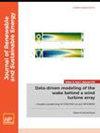Coordinated frequency control study of variable speed variable pitch of DFIG load shedding unit based on VSG
IF 1.9
4区 工程技术
Q4 ENERGY & FUELS
引用次数: 0
Abstract
The involvement of wind turbines operating at load shedding levels in primary frequency regulation serves as a crucial technical solution to provide high levels of inertial response capability and frequency regulation capability in power systems with significant proportions of renewable energy. Load-shedding units' frequency regulation capacity is constrained by the optimal operating speed, which prevents the utilization of the rotor's full kinetic energy and consequently limits the system's ability to provide strong inertia support. Additionally, the units are restricted by the maximum speed in the medium wind speed range, resulting in a reduced reserve capacity. The control mechanism of virtual synchronous generator (VSG) can ensure voltage stability at the machine end, and enable real-time tracking of the grid frequency, thereby imparting to wind turbines the on-grid operation characteristics of synchronous generator sets. To achieve this goal, this paper proposes a coordinated frequency control method for variable-speed variable-pitch doubly fed induction generator units based on VSG. Differentiated control strategies are employed for varying wind speed ranges, while an additional frequency control module is utilized to realize frequency regulation functionality. In conjunction with VSG, this approach enhances the inertial response of the units and strengthens their ability to support grid frequency. Simulation results indicate that the proposed control method mitigates the rate of decline in grid frequency and reduces frequency deviation, ultimately promoting grid stability. Additionally, a simulation system was designed based on the conventional four-machine two-area model to verify the effectiveness of this approach.基于 VSG 的双馈变流器变速变桨距甩负荷装置的协调频率控制研究
在一次频率调节中使用甩负荷运行的风力涡轮机是一种重要的技术解决方案,可为使用大量可再生能源的电力系统提供高水平的惯性响应能力和频率调节能力。甩负荷机组的频率调节能力受到最佳运行速度的限制,无法充分利用转子的动能,从而限制了系统提供强大惯性支持的能力。此外,机组还受到中等风速范围内最高转速的限制,导致储备能力下降。虚拟同步发电机(VSG)的控制机制可确保机端电压稳定,并实现对电网频率的实时跟踪,从而赋予风力发电机组同步发电机组的并网运行特性。为实现这一目标,本文提出了一种基于 VSG 的变速变桨距双馈异步发电机组协调频率控制方法。针对不同的风速范围采用不同的控制策略,同时利用额外的频率控制模块实现频率调节功能。这种方法与 VSG 相结合,提高了机组的惯性响应,增强了其支持电网频率的能力。仿真结果表明,所提出的控制方法可减轻电网频率的下降速度,减少频率偏差,最终促进电网稳定。此外,还根据传统的四机两区模型设计了一个仿真系统,以验证该方法的有效性。
本文章由计算机程序翻译,如有差异,请以英文原文为准。
求助全文
约1分钟内获得全文
求助全文
来源期刊

Journal of Renewable and Sustainable Energy
ENERGY & FUELS-ENERGY & FUELS
CiteScore
4.30
自引率
12.00%
发文量
122
审稿时长
4.2 months
期刊介绍:
The Journal of Renewable and Sustainable Energy (JRSE) is an interdisciplinary, peer-reviewed journal covering all areas of renewable and sustainable energy relevant to the physical science and engineering communities. The interdisciplinary approach of the publication ensures that the editors draw from researchers worldwide in a diverse range of fields.
Topics covered include:
Renewable energy economics and policy
Renewable energy resource assessment
Solar energy: photovoltaics, solar thermal energy, solar energy for fuels
Wind energy: wind farms, rotors and blades, on- and offshore wind conditions, aerodynamics, fluid dynamics
Bioenergy: biofuels, biomass conversion, artificial photosynthesis
Distributed energy generation: rooftop PV, distributed fuel cells, distributed wind, micro-hydrogen power generation
Power distribution & systems modeling: power electronics and controls, smart grid
Energy efficient buildings: smart windows, PV, wind, power management
Energy conversion: flexoelectric, piezoelectric, thermoelectric, other technologies
Energy storage: batteries, supercapacitors, hydrogen storage, other fuels
Fuel cells: proton exchange membrane cells, solid oxide cells, hybrid fuel cells, other
Marine and hydroelectric energy: dams, tides, waves, other
Transportation: alternative vehicle technologies, plug-in technologies, other
Geothermal energy
 求助内容:
求助内容: 应助结果提醒方式:
应助结果提醒方式:


